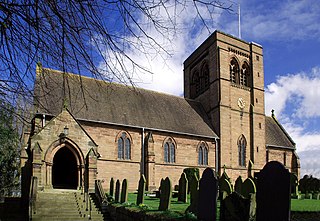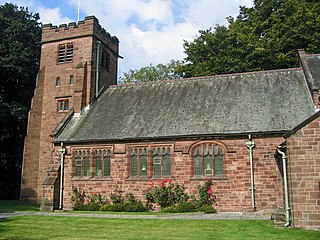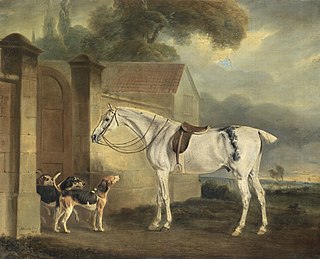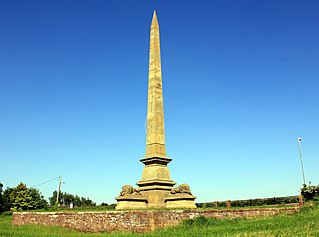The Bluecap Memorial stands in the yard of the Cheshire Hunt Kennels in Kennel Lane, Sandiway, Cheshire, England. Bluecap was a Cheshire foxhound that was famous for winning a race against the hounds of Hugo Meynell of the Quorn Hunt in 1763. The memorial is in sandstone and consists of an obelisk standing on a plinth, with a brass plaque inscribed with a poem. It is recorded in the National Heritage List for England as a designated Grade II listed building.
Bluecap (or Blue Cap) was a foxhound owned by John Smith-Barry, son of the 4th Earl of Barrymore, and was a member of the first pack of foxhounds to be founded in Cheshire. The pack was housed in Forest Kennels, Speedwell Hill. In 1763 Smith-Barry was challenged to a bet by Hugo Meynell of the Quorn Hunt, one of the most influential men in the development of fox-hunting, to a race between two of each other's hounds. The race was held over a four-mile course at Newmarket. Meynell's hounds were favourites at odds of 7–4, but Bluecap won easily, and Bluecap's daughter, Wanton, came second. Bluecap became a legend in northwest England, outstripping the rest of the pack, and died at the age of 13 in 1772. Smith-Barry arranged for the memorial to be made, and it was initially erected at Speedwell Hill, being moved to its present position in the yard of the Cheshire Hunt Kennels in 1959. The sculptor of the memorial is unknown. [1]
The memorial is constructed in buff and pink sandstone, and stands 200 centimetres (6.6 ft) high. [1] It is surrounded by a low wall and railings. The memorial has square base, and consists of a square pier with a moulded plinth and cornice, which is surmounted by an obelisk. On the north face of the pier is a brass plate inscribed with details of the foxhound and its owner, followed by a poem, all in copperplate script. [2] The inscription reads as follows: [3]
- To the Memory of old Bluecap a Fox Hound the late Property of the Hon. John Smith Barry
- This obelisk Reader is a Monument rais'd
- To a shade, tho' a Hound, that deserves to be prais'd
- For if Life's but a Stage where on each act a Part
- And true greatness a Form, that's deriv'd from the Heart
- If Fame, Honour and Glory depend on the Deed
- Then O Bluecap, rare Bluecap, will boast of thy Breed
- If not a Tear, yet a Glass, will we pour on the Brute
- So high fam'd as he was in the glorious Pursuit
- But no more of this Theme, since the Life's but a Race
- And Bluecap but gone to the Death of the Chace
Bluecap was a great favourite locally, and was painted at least twice. One of the paintings was commissioned by the Tarporley Hunt Club, and hangs in the Swan Hotel in Tarporley. Another painting was executed by Francis Sartorius in 1774. The foxhound is also commemorated in Ballads and Legends of Cheshire, written by Egerton Leigh in 1867, and the Blue Cap Inn in Sandiway is named after it. [1]
The memorial was designated as a Grade II listed building on 18 July 1986. [2] Grade II is the lowest of the three grades of listing and is applied to "buildings of national importance and special interest". [4]

Cuddington is a civil parish and rural village in the unitary authority of Cheshire West and Chester and the ceremonial county of Cheshire, England, about 4 miles west of Northwich and 13 miles east of Chester.

Norley is a village and civil parish in Cheshire, England, north of Delamere Forest, near the village of Cuddington. The population at the 2011 census was 1,169. Its name is derived from “Norlegh”, which means “north clearing”.

The Round Tower Lodge, also known simply as the Round Tower, is situated in the central reservation of the A556 road in Sandiway, Cheshire, England. It is recorded in the National Heritage List for England as a designated Grade II listed building.

Sandiway is a village in the civil parish of Cuddington, Cheshire, England. It lies to the southeast of and is contiguous with the village of Cuddington.

St John the Evangelist's Church is in the village of Sandiway, Cheshire, England. It is an active Anglican parish church of Sandiway and Cuddington in the diocese of Chester, the archdeaconry of Chester and the deanery of Middlewich. The church is recorded in the National Heritage List for England as a designated Grade II listed building.

Oakmere Hall is a large house to the southwest of the villages of Cuddington and Sandiway, Cheshire, England, near the junction of the A49 and A556 roads. It is recorded in the National Heritage List for England as a designated Grade II listed building. It was originally a private house and later became a rehabilitation centre and hospital. It has since been divided into residential apartments.
Hound trailing, or hound racing, is a dog sport that uses specially bred hounds to race along an artificially laid scent trail over a cross country course.

The Quorn Hunt, usually called the Quorn, established in 1696, is one of the world's oldest fox hunting packs and claims to be the United Kingdom's most famous hunt. Its country is mostly in Leicestershire, together with some smaller areas of Nottinghamshire and Derbyshire.

The Cottesmore Hunt, which hunts mostly in Rutland, is one of the oldest foxhound packs in Britain. Its name comes from the village of Cottesmore where the hounds were kennelled.
Model Cottage, Sandiway is a house in the village of Sandiway, Cheshire, England. It is recorded in the National Heritage List for England as a designated Grade II listed building. Designed by the Chester architect John Douglas and built in approximately 1879, the two-storey property is made from orange brick and features a Welsh slate roof. The main front has two gabled bays and an extension to the right. The left bay has a single-light window in the lower storey and a five-light mullioned window with semicircular arches in the upper storey. Between the storeys is brick diapering with plaster infills. In the gable above the window are square plaster panels surrounded by brick. The right bay projects forwards and has five-light mullioned arched windows on both storeys; it is without decoration. In the angle between the bays is a single-story porch with a four-light straight-headed mullioned window. There are two tall brick chimney stacks.
The Homestead is a large house in Weaverham Road, Sandiway, Cheshire, England. It is recorded in the National Heritage List for England as a designated Grade II listed building.
The Tarporley Hunt Club is a hunt club which meets at Tarporley in Cheshire, England. Founded in 1762, it is the oldest surviving such society in England. Its members' exploits were immortalised in the Hunting Songs of Rowland Egerton-Warburton. The club also organised the Tarporley Races, a horse racing meeting, from 1776 until 1939. The club's patron is HRH The Prince of Wales.
Quorn Hall is a grade II listed country house in the village of Quorn, Leicestershire.
Cuddington is a civil parish in Cheshire West and Chester, England. It contains 15 buildings that are recorded in the National Heritage List for England as designated listed buildings, all of which are listed at Grade II. This grade is the lowest of the three gradings given to listed buildings and is applied to "buildings of national importance and special interest". In the parish are two villages, Cuddington and Sandiway, which are contiguous. The architect John Douglas was born in the village of Sandiway, and seven of the buildings in the list were designed by him, including the village church and its lychgate.

The Barnston Memorial is an obelisk in Churton Road, Farndon, Cheshire, England. It commemorates Roger Barnston, a military officer who died in 1857 from wounds sustained at the Siege of Lucknow. His memorial consists of an obelisk standing on a plinth, surrounded by four lions. It is recorded in the National Heritage List for England as a designated Grade II* listed building.

Widnes War Memorial stands in Victoria Park, Widnes, Cheshire, England. It commemorates the serving men who lost their lives in the two world wars. The memorial consists of an obelisk in Portland stone on a plinth of York stone. It was unveiled in 1921, and more names were added in 1950. The monument is recorded in the National Heritage List for England as a designated Grade II listed building.

The Monumental Obelisk, Southport, stands on the Promenade in Southport. Merseyside, England. It commemorates a number of events, mainly relating to the work of the Southport lifeboats, and in particular the loss of fourteen lifeboatmen when their boat capsized in 1886. The monument was designed by Thomas Robinson, and is constructed in granite. It is recorded in the National Heritage List for England as a designated Grade II listed building.

The Lifeboat Monument, St Annes, stands on South Promenade, St Annes, Fylde, Lancashire, England. It commemorates the death of 13 lifeboatmen from St Annes who were lost in the attempt to rescue the crew of the German barque Mexico that had been driven into a sandbank in a gale in December 1886. The lifeboat from Southport also lost 14 of its 16 man crew in the disaster. The monument depicts a lifeboatman looking out to sea and standing on a rock-like plinth. It is recorded in the National Heritage List for England as a designated Grade II listed building.

The Lifeboat Memorial, Lytham, is in the churchyard of St Cuthbert's Church, Lytham St Annes, Fylde, Lancashire, England. It commemorates the death of 27 lifeboatmen from Southport and St Annes who were lost in the attempt to rescue the crew of the German barque Mexico that had been driven into a sandbank in a gale in 1886. The memorial is in the form of a Gothic-style tabernacle with a crocketed pinnacle. It is recorded in the National Heritage List for England as a designated Grade II listed building.

The Warwickshire Hunt is an English fox hunting pack founded in 1791.
Citations
Sources